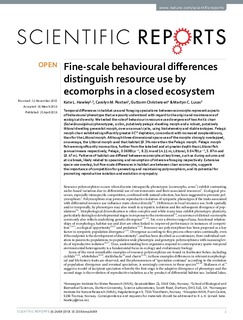Fine-scale behavioural differences distinguish resource use by ecomorphs in a closed ecosystem
Journal article, Peer reviewed
Published version
Date
2016Metadata
Show full item recordCollections
- Publikasjoner fra Cristin - NIVA [2160]
- Scientific publications [1172]
Abstract
Temporal differences in habitat use and foraging specialisms between ecomorphs represent aspects of behavioural phenotype that are poorly understood with regard to the origin and maintenance of ecological diversity. We tested the role of behaviour in resource use divergence of two Arctic charr (Salvelinus alpinus) phenotypes, a slim, putatively pelagic-dwelling morph and a robust, putatively littoral-dwelling generalist morph, over an annual cycle, using biotelemetry and stable isotopes. Pelagic morph charr exhibited significantly greater δC13 depletion, concordant with increased zooplanktivory, than for the Littoral morph. Although three-dimensional space-use of the morphs strongly overlapped, on average, the Littoral morph used that habitat 19.3% more than the Pelagic morph. Pelagic morph fish were significantly more active, further from the lake bed and at greater depth than Littoral fish (annual means respectively, Pelagic, 0.069BLs−1, 8.21 m and 14.11 m; Littoral, 0.047BLs−1, 5.87 m and 10.47 m). Patterns of habitat use differed between ecomorphs at key times, such as during autumn and at ice break, likely related to spawning and resumption of intensive foraging respectively. Extensive space-use overlap, but fine-scale differences in habitat use between charr ecomorphs, suggests the importance of competition for generating and maintaining polymorphism, and its potential for promoting reproductive isolation and evolution in sympatry.

